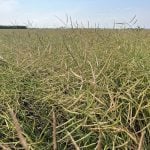By Commodity News Service Canada
Winnipeg – Following are a few highlights in the Canadian and world feed grains markets on Thursday, October 19.
Prices for feed wheat in Saskatchewan are holding steady, according to the latest information from the Prairie Ag Hotwire. Bids are listed as C$3.90 to $4.80 per bushel.
Oat prices in Manitoba rose four cents and are going for C$2.82 to C$2.99 per bushel.
Feed barley bids in the key cattle feeding area of
Lethbridge, Alberta were in the C$210 to C$212 per tonne range
Read Also
Canadian Financial Close: Canadian dollar steady
By MarketsFarm WINNIPEG, May 22 (MarketsFarm) – The Canadian dollar rallied after previous losses, to close steady on Wednesday. The…
Corn futures on the Chicago Board of Trade ticked up half a cent on Thursday. The market continues to be locked in sideways trade. Weekly corn sales of 1.25 million tonnes came in
above trade expectations, which was supportive. However, improving weather conditions in the U.S. Midwest and Chinese auctions limited the gains.
In North Dakota, corn prices fell one cent per bushel, according to the hotwire, and are going for C$3.12 to C$3.35 a bushel.
A new report by the USDA’s Brazilian attaché suggests Brazil’s record corn production has led to record exports. In 2016/17 corn production was estimated to be 97.7 million tonnes, a new record for the South American country. Exports for 2016/17 have been pegged at 35 million tonnes, which would be than double the export volume of the previous year.
In Australia, the state of New South Wales went through the driest September on record. According to government statistics, below average rainfall was recorded across 92 percent of the state. Some daytime temperatures were also broken with two days in the month recording two of the hottest September temperatures ever. Many crops were cut for hay or silage as a result while pasture growth remains low to moderate in many areas.









